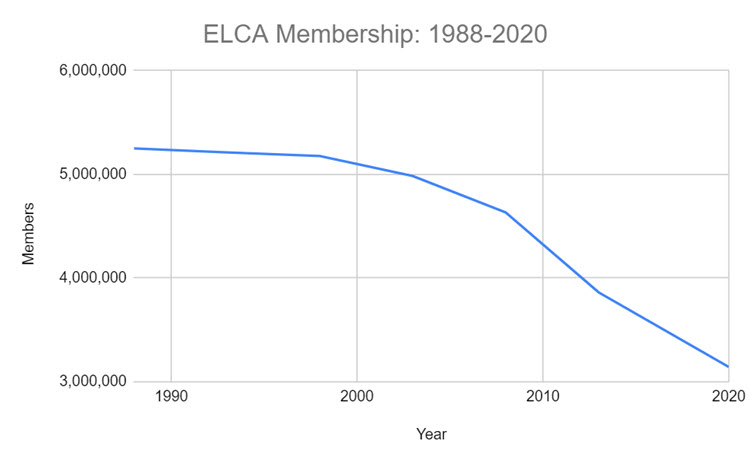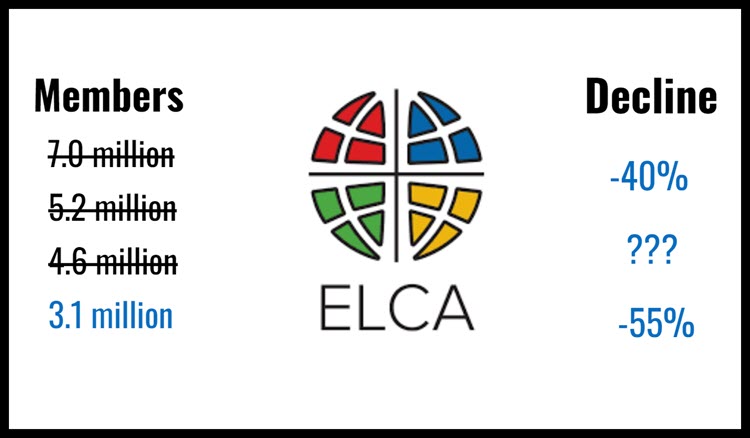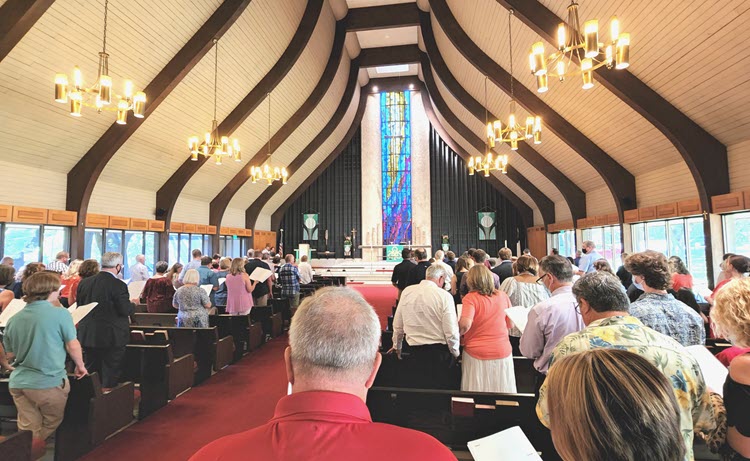The Evangelical Lutheran Church in America (ELCA) was formed in 1988 by the merger of three Lutheran denominations: American Lutheran Church, the Association of Evangelical Lutheran Churches and the Lutheran Church in America.
And, almost every year since its creation, the denomination has experienced a decline in membership. This trend is consistent with what has happened in Mainline Protestantism at large (a grouping used by sociologists for seven theologically progressive denominations, including the ELCA) during this time period.

Membership Decline
According to ELCA reports, baptized membership by year between 1988 and 2020 has decline as follows:
- 1988: 5,251,534
- 1993: 5,212,785
- 1998: 5,178,225
- 2003: 4,984,925
- 2008: 4,633,887
- 2013: 3,863,133
- 2020: 3,142,777

Rate of Decline
The data above follows the decline in five year increments for the first 25 years (1988-2013). Since 2020 is the most recent data available, I opted to use 2020 as the final data point.
This means the loss in membership per five (or seven) years is
- 1993 -38,749
- 1998 -34,560
- 2003 -193,300
- 2008 -351.038
- 2013 -770,754
- 2020 -720,356
Or, expressed in an annualized manner
- 1993 -7,750
- 1998 -6,912
- 2003 -38,660
- 2008 -70,208
- 2013 -154,151
- 2020 -102,908
Alternatively, the decline can be expressed as a percentage. The percent decline per five (or seven) years is
- 1993 -0.74%
- 1998 -0.65%
- 2003 -3.75%
- 2008 -7.04%
- 2013 -16.62%
- 2020 -18.66%
Or, when percentages are annualized
- 1993 -0.15%
- 1998 -0.13%
- 2003 -0.75%
- 2008 -1.41%
- 2013 -3.32%
- 2020 -2.67%

Perspective
From 1988 to 2020, the ELCA declined by 2,108,757 members or 40.16%. While the data above shows the decline has increased in recent years, the overall average rate of decline for this period was 1.26%.
By comparison, the Presbyterian Church (USA) – another Mainline Protestant denomination – was founded by a merger in 1983. In the PCUSA’s first 35 years membership declined by 56.8% from 3,131,228 to 1,352,678 or at an average annual rate of 1.62%. (For more about the PCUSA’s decline read Presbyterian Decline: PCUSA -The First 35 Years).

Additional Consideration
While the data above provides a detailed overview of the decline in membership in the ELCA it does so with no consideration for changes in context. More specifically, the numbers show decline over a 32 year period during which the United States population was growing. To maintain market share, the ELCA would have had to grow dramatically between 1988 and 2020.
If stability equated to market share, then the denomination’s decline over this time period is adjusted to 55.1% (for more on this check out The ELCA is Missing 4 Million People!).
So What?
I’ve been a Mainline Protestant my entire life, including spending a few years serving at King of Glory Lutheran Church in Dallas. This year, I’ve spent time in several ELCA congregations, including preaching at Central Lutheran Church in Dallas and First United Lutheran Church in Dallas.
For me, these numbers are personal. They speak to the numeric changes that have happened in my lifetime. And, they also remind me that while the denomination is experiencing decline individual congregation’s experiences vary widely: some were not yet founded in 1988, some have declined more dramatically, some have been largely stable numerically, and others have experienced moderate or even dramatic growth.
If you are currently involved in an ELCA congregation, I’d welcome hearing how your congregation has changed since 1988 and how the declines in the denomination have impacted your congregation.